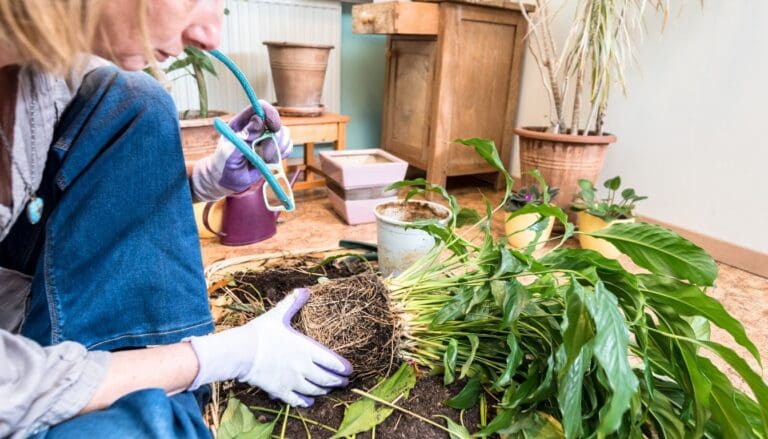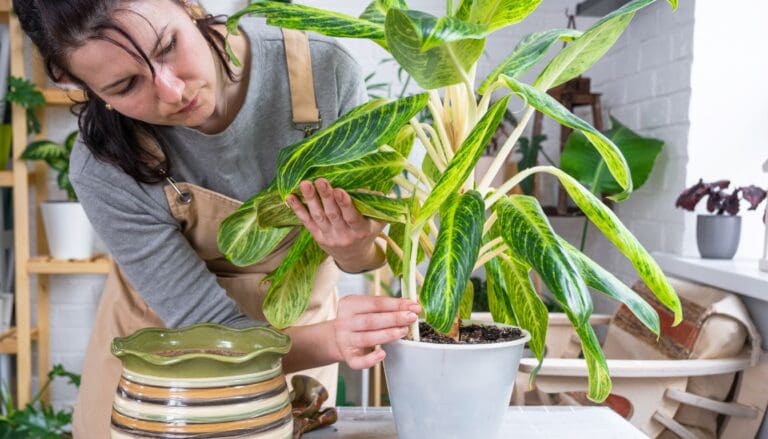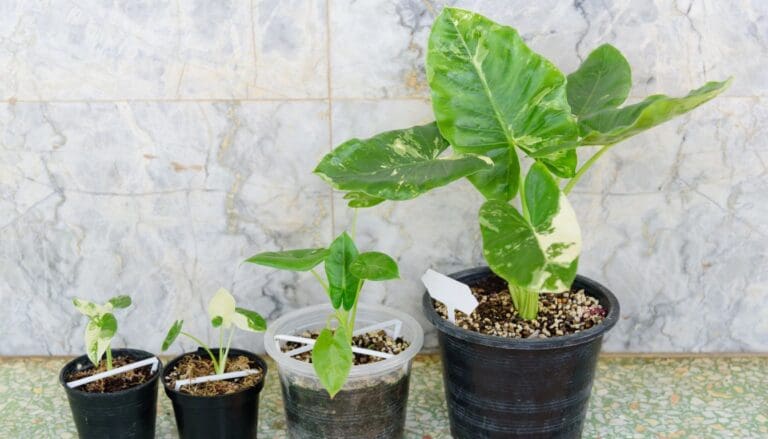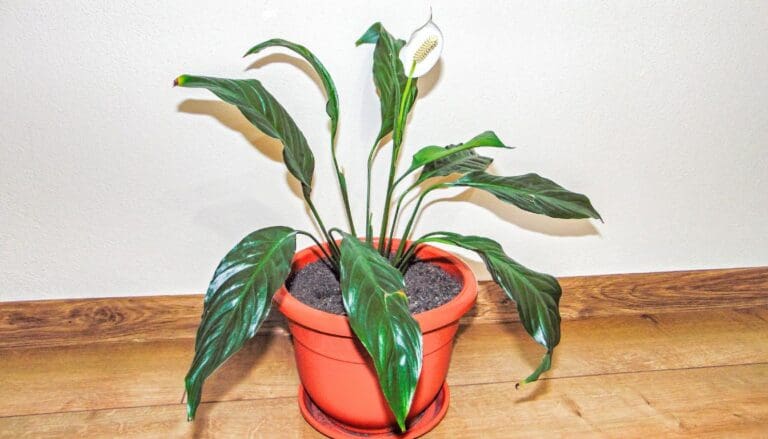10 Reasons Why Your ZZ Plant Is Turning Brown
ZZ plants are gaining popularity due to their ability to thrive under low maintenance. But it may show signs if something goes wrong with it. If you notice that your ZZ plant’s leaves are turning brown, you need to understand that it needs your help! But why is your ZZ plant turning brown, and what can you do about it?
Low light, overwatering or underwatering, poor water quality, and low humidity can turn the leaves of your ZZ plant brown. Avoid the use of chlorinated water and only water the plant when the soil feels dry. Moving the ZZ plant to a medium-light spot can also help prevent brown leaves.
Let’s discuss this in detail so that you can identify the problem early on and deal with it by taking some easy steps and save your ZZ plant from turning all brown before it’s too late.
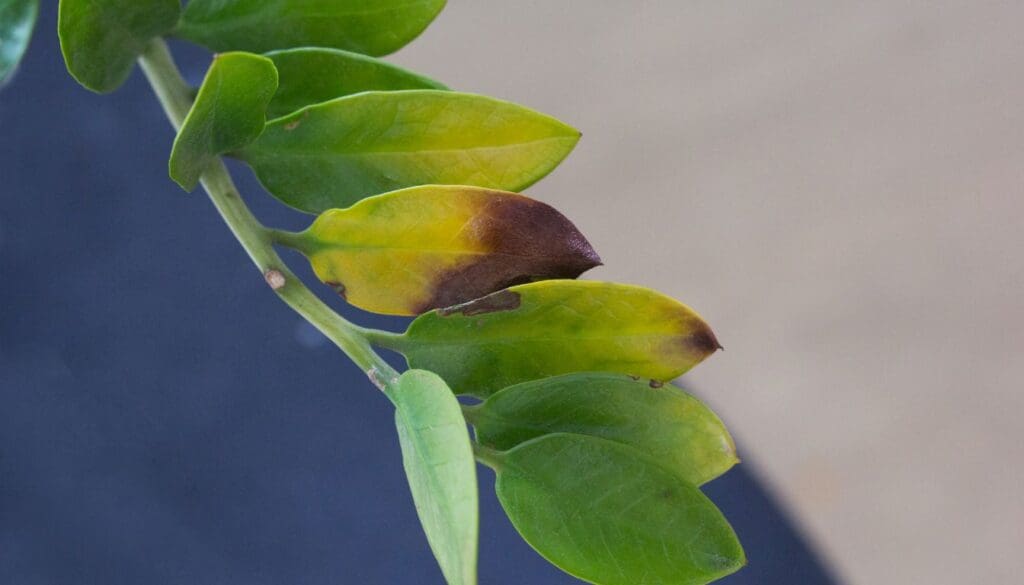
Please note: Simplify Plants is reader-supported. Some links in the post are affiliate links and I get a commission from purchases made through links in the post.
ZZ plant leaves turning brown
There can be several causes of brown leaves in the ZZ plant. However, you can quickly fix the problem of brown leaves if you can find the right cause. Let’s dive into further details.
Poor water quality
You may not know this, but the water that you are giving to your ZZ plant may have minerals that are not suitable for it.
Causes
ZZ plants are intolerant to some elements such as chlorine, fluorine, and salt. If your water has all these minerals present in it, it can harm the ZZ plant.
These minerals will start to build up in the soil and reach the plant from the soil.
The effect of this will be that the leaves will start turning brown.
Solution
Check out these easy fixes to deal with this problem.
- Use rainwater or alternate water sources to be sure that these will be free from harmful elements like chlorine and fluorine.
- Don’t use tap water directly. If you have been using tap water till now and your plant is suffering, the chances are that it will have those harmful elements.
- You can keep the tap water in an aerated area outside for 24-48 hours, which might reduce the amount of these elements in the water.
- You can install a water filter so that you can filter your tap water and get the harmful minerals out of the water before giving it to your ZZ plant.
If you start following these steps, your ZZ plant will soon recover, and you won’t see any more brown leaves.
Overwatering your ZZ plant

Overwatering is one of the most common problems in ZZ plants that can cause damage to the plant in many ways.
It may be hard to understand how much water the plant needs initially, but you will learn it eventually.
If you are a beginner, I recommend using a moisture meter to detect the soil’s humidity and water the plant accordingly.
Causes
If you have not done your research right, you might end up overwatering your plant.
Overwatering causes root rot in plants, and the plant cannot get the required nutrients from the roots. You will get a musty smell from the soil if it is root rot.
If your ZZ plant shows signs like leaves turning brown and mushy or falling off from the stems, overwatering might be the cause.
Solution
If you think overwatering is causing your ZZ plant to turn brown, check out the following solutions.
- Keep checking the soil to find out if it is moist and water only when it gets dry.
- If it is root rot, clip off the damaged roots with a pair of sterilized scissors and cut off leaves that have turned brown.
- If there is a stem that has a lot of brown leaves, cut off the stem.
- Repot the plant in fresh potting soil so that the plant can start to recover.
Once you have given enough time to your ZZ plant to recover, maintain a balanced schedule of watering the plant so that you don’t end up overwatering it.
Also read: How much water do ZZ plant need?
Under-watering your ZZ plant
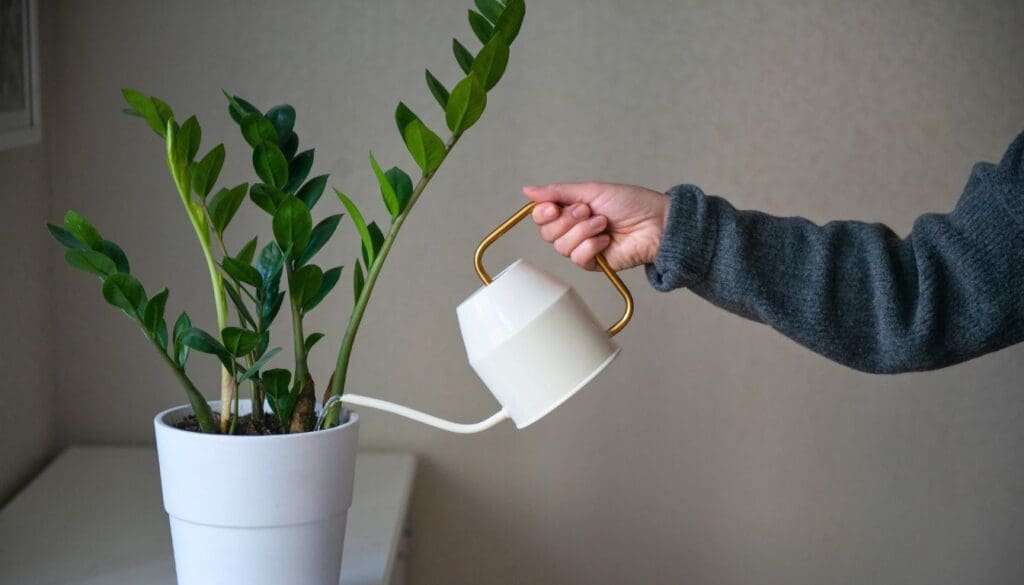
Underwatering is a rare problem in ZZ plants as these are hardy plants that do not need a lot of water like most plants. However, it can show signs of underwatering through dry and brown leaves.
Causes
ZZ plants will survive with less water, but eventually, they will show signs of a problem.
If you forget to water your ZZ plant and make it stay without water for long, it will start turning the leaves brown, leading to bad health.
Solution
- You need to keep a check on the moisture of the soil.
- If you find that the soil is moist, wait for a few days before watering the plant again.
- If your ZZ plant looks dry and tired and the soil feels dry, water it a bit more than you usually do.
- Please don’t give it a lot of water at once as that can damage the plant. You do not want to shock the plant by giving a lot of water all at once. Instead, try to give a little water to it at a frequent interval so that it can adjust to that and recover.
- Trim the brown leaves so that the plant can focus on new growth.
When noticed at an initial stage, underwatering is easily manageable, and you get enough time to work on the issues, which will lead to a speedy recovery for your ZZ plant.
Also read: Underwatering vs Overwatering
Low humidity around your ZZ plant

Low humidity is a common problem that people face during the winter season.
Causes
During the winter months, the air gets dry due to cold weather. The ZZ plants suffer due to lack of humidity, and the leaves droop down, become dry, crisp, and turns brown.
There are specific steps to deal with this problem.
Solution
- Give your ZZ plant a good shower – If you want to raise the humidity and give the plant relief from the dryness, shower it.
- Wash the plant gently with lukewarm water. That will give the leaves a good cleaning, and the soil will soak the water.
- Ensure that the water pressure is low so that the plant doesn’t suffer more damage.
- Relocate your ZZ plant to the bathroom– Your bathroom may be the best place for your ZZ plant. The water coming out of the shower will provide the required humidity to the plant.
- If your bathroom has enough light, then the ZZ plant will thrive in that area.
- Humidifier– Humidifiers help control humidity level, and the use of humidifiers are increasing as they are beneficial devices in the household.
- Humidifiers control the humidity level that will help your ZZ plant not to get dry and brown leaves.
- Spray water on your ZZ plant – This is one of the easiest things you can do. If you spray water on the leaves a few times a week, that will help increase your ZZ plant’s humidity.
If you can increase the humidity by following these steps, your ZZ plant will not get dry, and you will not see any more leaves turning brown.
Also read: Does ZZ plant need misting? (+Ideal humidity)
Your ZZ plant is stressed

Transplantation of ZZ plants is required as the plant grows bigger and outgrows the pot.
Causes
If the transplantation has not been done correctly, the ZZ plant will go through a shock and have stress. The plant will show signs of stress through the leaves, which will wilt, turn brown, and fall off.
Solution
In case you are going to repot the ZZ plant, check out the following points to avoid giving shock or stress to the plant.
- Choose the right pot when you are repotting the ZZ plant. The pot should have drainage holes and should be of the right size.
- Be careful while removing the ZZ plant from the previous post, as any damage can shock the plant.
- Cut off any damaged part that you notice.
- Repot carefully and water the plant after you have successfully transplanted it.
In case your plant is suffering from shock or stress after being transplanted, you can take care of the following points.
- If you notice any problem like brown leaves, trim those so that the plant can focus all the energy on new growth.
- Provide enough water and make sure that the excess water is getting drained.
- Provide fertilizer so that the plant gets enough nutrition that will help them come out of the shock.
- Keep the plant at the previous location that will provide the same light or temperature conditions. That will help them recover fast.
Stress or shock can be hard to determine, but if everything else fails and if you have repotted your plant recently, chances of shock or stress remain.
Follow the steps mentioned above to make sure that your plant can recover and stop turning brown.
Also read: How to revive a dying ZZ plant?
Your ZZ plant got too much sun
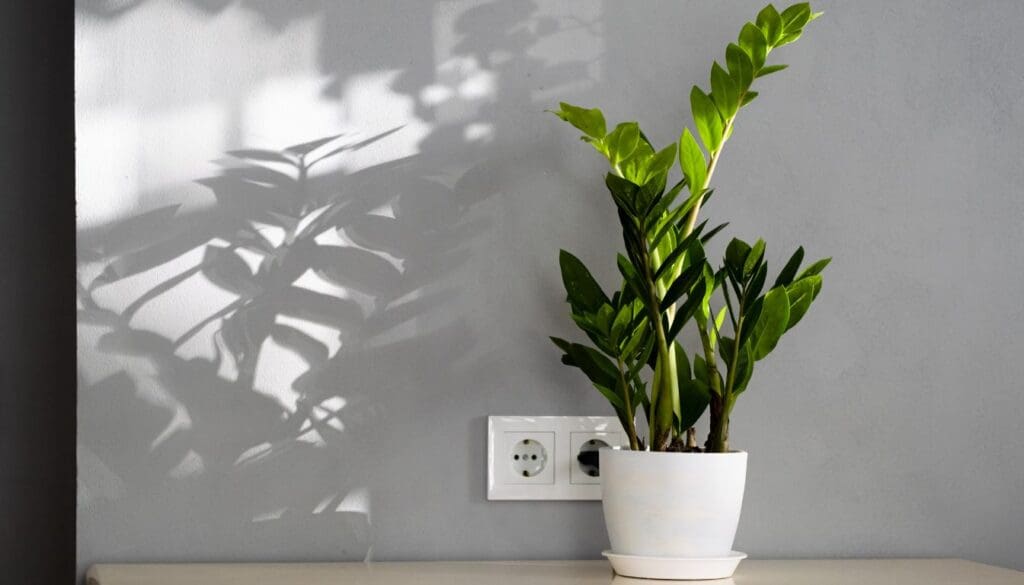
ZZ plants do not like direct sunlight as it gets too harsh for them. Too much exposure to the sun can cause sunburn in plants.
Causes
If your ZZ plant is located in an area where it is being exposed to direct sunlight, the leaves will start to get scorched.
The leaves will turn brown and will get tanned.
Solution
The easy fix would be to place your plant in a cooler area that does not get direct sunlight but is bright and has indirect light.
If the plant has already been exposed to direct sunlight for some time and you can see that some of the leaves have turned brown, then you can follow the steps below.
- Don’t fertilize the plant until it recovers. Fertilizers can add to the burning effect and make the plant dry, so you should avoid it until the plant needs it again.
- It would be best if you reduced watering the plant. The plant will have leaves that have turned brown, which you should trim.
- That will reduce the foliage of the plant, and therefore it will not require as much water as it used to.
Also read: How much light do ZZ plant need?
Lack of nutrients in ZZ plant

Your ZZ plant might be suffering from a lack of nutrition if you haven’t fertilized them in a while. Sometimes ZZ plants do not get the amount of nutrition that they need.
Causes
Lack of nutrients can cause discoloration. Plants that have nutrient deficiency will have brown leaves.
If you want a ZZ plant that receives good nutrition, you should provide it a combination of micronutrients and macronutrients.
There should be a good balance as the plants need more macronutrients and fewer micronutrients.
These are available in the soil, but if the ZZ plant is still suffering from malnutrition, the soil needs to be checked. You might need to change the composition of the soil.
Solution
You can keep a check on the composition of the soil. The composition of the soil plays a vital role in the retention and absorption of nutrients.
The plant will not be able to absorb the nutrients from the soil if the soil composition is inappropriate.
- The soil for the ZZ plant should be well-draining, but at the same time, you need to add some peat moss, compost, or worm castings to the soil so that it can retain some moisture and hold nutrients for the plant.
- You may consider checking the pH level as the plant needs a pH level of 6.0 to 7.0 to absorb the nutrients.
- Make sure you are providing the right amount of water to the ZZ plant. Providing less water or more water than what is required will be harmful as the plant will not take the nutrients in.
Inappropriate pot
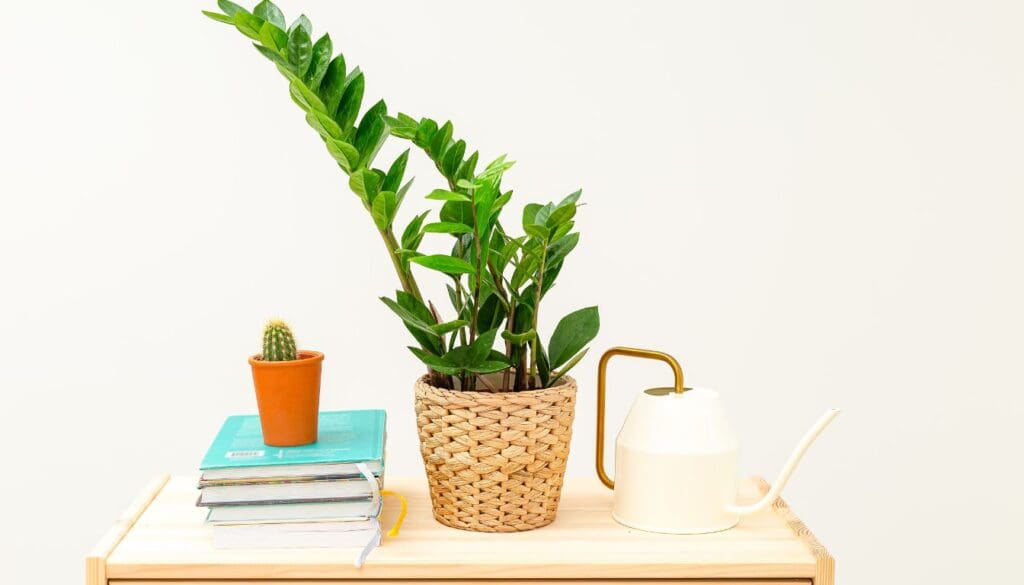
Using a pot that is not suitable for your ZZ plant will make the leaves turn brown.
Causes
If you have a small pot, the plant will feel restricted, and if the pot is too big, it will retain more water which will give rise to root rot.
If the pot is not the right size, your plant will not be able to grow correctly. It would be best if you chose a pot that is one size bigger than what is needed. That is because the ZZ plant is a fast-growing plant.
Solution
- As mentioned, get a pot that is one size bigger than what is needed for the plant. It will let the ZZ plant grow freely.
- The pot should have drainage holes so that excess water can drain away, and there won’t be any chances of root rot.
- Try not to use plastic pots. Instead, use clay or ceramic pots. These pots will be able to hold the plant as it gets bigger and heavier with time.
- Also, clay pots will be able to keep the soil dry without retaining water.
If you use the right pot, it will help your ZZ plant to grow without feeling restricted. If your plant remains healthy, you will not see brown leaves on it.
Also read: Do ZZ plant like to be root bound?(+Ideal Pot)
Plant rust
Plant rust is a problem that we can identify in many plants. Even your ZZ plant might be having plant rust, due to which it is turning brown.
Causes
Plant rust is a fungal infection that is found on matured plants. The signs show up on the lower surface of the leaves.
Low light, moisture, and warm temperature can be reasons for plant rust in your ZZ plant.
How to make sure that it is plant rust?
- Look for spots on the undersides of the leaves and also check the stems.
- The spots will become reddish-orange and then yellow-green. If not treated, it will turn black.
- If the infections are severe, the leaves will fall off.
Solution
- Trim or prune all the infected parts that you notice on your ZZ plant.
- Give the plant enough time to recover and provide organic fertilizer to the plant to ensure they are getting enough nutrients.
- Refrain from putting water on the leaves while watering the plant.
If you want to save your ZZ plant from plant rust:
- Don’t let the plant get too much moisture.
- Make sure that the water gets dried every time you water the plant.
- Keep your plant in an aerated area.
- Apply fungicide to make sure that your plant doesn’t develop these fungal infections.
Pest infestation

Pest infestation is not unusual, and it might be a reason why your ZZ plant is turning brown. It would be best if you kept an eye out to make sure your ZZ plant is not having a pest infestation.
Causes
Various pests like aphids, spider mites, flies, etc., attacks the ZZ plant. Pests can cause severe damage to your ZZ plant as they suck the sap out of the plant. That leads to brown leaves in the ZZ plant.
Solution
- Check to find out if your plant is infected or attacked by pests.
- Prune the infected parts of the plant.
- Make sure to use insecticides or natural methods like neem oil spray to ensure that the pests don’t come back and attack the ZZ plant again.
- If the plant is infected and other plants around it, move the ZZ plant to a different area so that the other plants do not get infected.
Final Words

If you can find out why your ZZ plant’s leaves turn brown, you will be able to take steps to get rid of the problem and take preventive measures so that the same doesn’t happen in the future.
Sources: ZZ plant study, College of agricultural studies, University of Vermont, National science foundation.
Recommended Garden Supplies
| Product Image | Our Recommended Gardening Supplies | Check Offers! |
|---|---|---|
Top Top
Top
Top
Top
Top
Top
Top
Top | rePotme Houseplant and Tropical Classic Potting Soil Mix | Check Offer On Amazon |
 Top
Top
Top
Top
Top
Top
Top
Top | Espoma Organic Indoor Plant Food | Check Offer On Amazon |
 Top
Top
Top
Top
Top
Top
Top
Top | GooingTop LED Grow Light 6000K Full Spectrum Clip Plant Growing Lamp | Check Offer On Amazon |
 Top
Top
Top
Top
Top
Top
Top
Top | Soil Moisture Meter | Check Offer On Amazon |
 Top
Top
Top
Top
Top
Top
Top
Top | Govee Hygrometer Thermometer, Bluetooth Enabled! | Check Offer On Amazon |
 Top
Top | LEVOIT Humidifiers for Large Room(Best For Plants) | Check Offer On Amazon |
 Top
Top
Top
Top
Top
Top
Top
Top | Upgraded DIY Automatic Drip Irrigation Kit, 15 Potted Houseplants Support | Check Offer On Amazon |
 Top
Top
Top
Top
Top
Top
Top
Top | Stainless Steel Heavy Duty Gardening Tool Set | Check Offer On Amazon |
 Top
Top
Top
Top
Top
Top
Top
Top | Bonide Insecticidal Soap | Check Offer On Amazon |
 Top
Top
Top
Top
Top
Top
Top
Top | Bonide 32 oz Spray Neem Oil for Organic Gardening | Check Offer On Amazon |
 Top
Top
Top
Top
Top
Top
Top
Top | Garden Safe Fungicide | Check Offer On Amazon |

